
|
A Terra Firma Tar |
|
|
The Globe and Mail's headline reads: Prairie Sons Make Naval History. The article published on March 23, 1947 states: "from the driest of Canadian dry land - the Western Prairies - come more sailors proportionately than from Canada as a whole". Twenty eight percent of Canada's population at that time1 was in the four western provinces, British Columbia, Alberta, Saskatchewan, and Manitoba; yet from that 28% came 40% of the strength of the Navy representing the numbers 19,000 out of 52,000 members. These Prairie Navy boys were referred to as 'terra firma tars'. The explanation for this "startling phenomena": the sea holding a special attraction for "the man who lives inland spelling romance and adventure. Lads born of the interior had read tales of the sea and longed to travel on its waters." The war gave these young men the opportunity. And as a bonus: they learned the vernacular of a sailor. George Crewe resident of Jaffray, British Columbia was born in landlocked Lethbridge, Alberta in November 1922. At the age of 17, he joined the Royal Canadian Navy and became a Boy Telegraphist. "I hated school with a passion and I thought this was the way to get out of it. I finished Grade 10 and part of Grade 11. When I got my results for my Grade 10, I put them away and I didn't show them to my mom or my dad until I got out of Navy seven years later. My mother said to me one day, 'I could never understand why you joined the Navy so young.' So I went into my dresser drawer and said, 'Read that!'" George laughs as he recalls this anecdote. "All I was interested in was sports and track and field! I loved hockey, too." When George was ten, he was given the gift of a thin little book entitled My Book on Sailors. "I always attributed that to me joining the Navy. I guess the stories and the pictures fascinated me. George attempted to join the Navy when he was sixteen years old. "The war was just barely getting going. I went to Calgary to the Recruiting Office. The guy looked at me. George has always had an interest in radio. "That is why I joined as a Boy Telegraphist in 1940: a Boy because I was under 18. I told them that is what I wanted. In those days, they agreed to that, for some reason. That doesn't happen these days." George signed on with the Royal Canadian Navy (RCN) for seven years as part of the permanent force. "I sent my application away and I got a reply in George recalls one of the young lads: "He got to Esquimalt and said, 'This isn't for me.'" He was gone within three days. "We had divisions where everybody had to go out on the parade square. We were still in our civilian clothes...all of us cowboys and what have you....and then, I'll never forget, they issued us our hammocks. We were given two hammocks: one you slept in and the other one was spare. In those days, the Navy slept in hammocks. Period. We were issued a mattress filled with kapok (shredded rope) and then two blankets. They were really good blankets, like Hudson's Bay Blankets without the stripes. Ours were cream coloured with a black stripe on the end; and no pillow!" Slipping easily into a mariner's lingo like it was yesterday, he describes how difficult he and the other new recruits found setting up their hammocks when they first arrived for naval training. "It was a real panic the first night. You slept right above the mess tables. We had fellas help us the first couple of nights to get them slung. The hammocks are about four to six feet off the ground. When you got into them (they are not like the ones in someone's back yard these days), the clews (the ropes) - when you got in, they kind of folded around you. They had posts and a long pipe going all the way across the building and we were slung side by side. It was a mass of hammocks. But pretty soon, you learned to get two sticks, 17" wide - for space because of the guy next to you. The sticks hold the hammock apart. You would have one at your head and one at your feet; you'd keep them with the hammock. I got my dad to make me some. I told him exactly what I needed. He notched them so that the outside clews would fit in and that was that. Other guys did the same thing, I guess. Some might have used dowels. Some didn't do it at all." "When you got up in the morning, you had to fold your blankets and put them inside and then you had a long rope. You lashed your hammock. You had to have seven turns, wrapped. That was for the seven seas....that was the story. That was it! That was the law. And if you didn't, you would have to do it over again." As George continues telling his story, one of his precious clocks chimes. "The discipline in those days was unbelievable! I think back in the Navy, they were very strict...more than in the Air Force. As far as I was concerned, the Air Force Personnel were a bunch of wimps. They had a bed to sleep in every night and sheets, too!" His eyes twinkle. "We lived in the barracks, of course; the Grenville Block. The 'boys' were all on the lower deck, with the older kids on the second floor. You were up at 5:30 am, got washed, and dressed in your PT shorts and three days out of the six, we would run three miles one way and three miles back. The other mornings we would do calisthenics. We would have to do everything 'on the double'." George still has his kit bag, now in storage. "When my wife and I still lived in Lethbridge, we went on holidays. They were excavating in the alley and then there was a terrific rainstorm. The water went down into our basement getting into the trunk where I had all my Navy stuff. Everything got wet. When we got home two weeks later, it was mildewed and I almost cried. But I saved my book, my kit bag and my hammock!" He itemizes what he received as a new recruit. "You got a uniform, two pairs of socks, one pair of boots, two shirts: one was heavy cotton and the other was flannel. The black shirt under the tunic indicated winter time and the white shirt under the tunic: summer. Then we had a long sleeved sweater for winter. We got long johns, too. "The clothes fit pretty good. I don't know how they did that. A sailor's uniform is pretty snug." Laughing and grinning at recalling his early training in the Navy, George continues: "We were taking 'boot training'; learning how to march. That didn't bother me at all, because in High School, they had Army Cadets, so I knew my left foot from my right! And we got a lot of needles!" "We started class at 8:00 am. We went to class for an hour. We had divisions, the whole ship's company - at Esquimalt, on land, the whole barracks, we had to fall in, we had a quick church service and God Save the King and then we went back to class until about 10:30 am or so. Then we got a coffee break for fifteen minutes - 'stand easy' it was called. Then back to class. Then you went for lunch then we returned to class until 4:00 pm when we went back to the barracks. At that time in the Canadian Navy, we followed the Royal Navy routine. We had 'tea': it was cocoa actually. Then one pound jam tins went on the table....and at each table where we ate, there would be ten guys. You would get one piece of bread, if you were lucky, and thick jam and the cocoa. I'll tell you - you had to get in there first; if you got in there last, all you saw when you looked into the tin was your face reflecting in the bottom!" George chuckles. "After that, you had a free time, but you had to go to the PT field to maybe play soccer or baseball. It was an organized free time. Just soccer and baseball. No hockey. I did miss hockey," he laments. "We had to be in bed by 9:00 pm every night at our age of 17. There was no chit chat. It was quiet." As the clock chimes in the background once more, George remarks proudly: "This is a true ship's clock. My wife bought it for me in Victoria some years ago." Easily, the former sailor explains: "A ship's clock is totally different. In the Navy, there are three watches. Noon - Four; Four to Eight; Eight to Twelve. Between 4 and 6 and 6 and 8, they call those Dog Watches...they are two hours. They have them that way so you are not on the same watch all the time and they alternate. At 12:30, it chimes once.....at 1:00: 2 chimes; 1:30: 3; 2:00: 4; 2:30: 5; 3:00: 6; 3:30: 7; 4:00:8. Then it starts all over again. And then again at 8:30."
The now 89 year old 'boy telegraphist' continues to share his training tales. "I learned pretty fast. You had to be spic and span. We didn't have washing machines....we used wash boards. We washed and ironed our own clothes from the time we entered the Navy until the day we left," he says proudly. "My mother had had an accident with the ringer washing machine when I was younger. Her hand went up to her elbow before she could press the release, breaking her arm. I had to learn how to wash clothes for her. This is how I learned how to make beds and do washing. So when I went into the Navy, it was nothing to it. I would iron the dickies and the white shirt and charge two bits....I would only iron the front because who would see the back?" he laughs. George effortlessly glides into his sailor's jargon "The first six weeks was basic training, and then we went into our classes which lasted about eight months. I found learning Morse Code very difficult, but in my opinion, everybody that has to take Morse Code finds it difficult." George recalls taking the streetcar into town from Esquimalt to Victoria, reading the advertisements above his head. "I would sit there and read them for practice. I did alright. I managed to pass." Accuracy was key. "When you start receiving Morse Code, you don't get a second chance. By the time you finished the class, you were very fluent in sending and receiving." When George finished his course, he was the first person out of twelve in the wireless operators to be drafted to a ship. "The other guys were envious. I don't know how I got drafted first. My marks were not the best, I know that!" he chuckles. "I was slated to go to Ottawa as a Wireless Operator, receiving and transmitting messages to and from Ottawa. I did not find this out until I got my military records a couple of years ago. I am so glad I didn't get that posting. Somehow, they drafted me to The Quinte with a signal that said, 'He's already been selected.'" George then fulfilled his seven years of service with the Royal Canadian Navy on a variety of ships, his favourite being The Quinte. "The Quinte was my love as far as the ships were concerned." In the summer of 2010, George was in Victoria, British Columbia watching the review of the fleet. "A woman and her mother sat beside me and we got to talking. I mentioned how disappointed I was that they didn't have any open ships and how I would love to have gotten on board to see one of those ships today. She told me her husband was in the Navy but was away. She asked for my phone number and she was going to check to see what she could do." Two days later, George received a call to meet her and they would have the opportunity to go on board the newer auxiliary. George's daughter, Catherine, and the woman joined George and the coxman who appointed someone to escort them aboard. "There was a young lady - they've got ladies on board now!" George exclaims. "We were on the ship for about an hour. We saw the whole thing. I couldn't believe my eyes! Gosh. They have bunks now...four to a room. They even let them drink beer on the ship. They can have beer from the canteen. They have a little room with exercise equipment. I just shook my head." George recounts the rest of that day. "They took me into the radio room. They might as well have taken me into a Chinese Room because the equipment that was in there was unbelievable. I didn't even know what I was looking at. It was all computerized. They don't even have to know the Morse Code now. I don't know why. One of these days - if something happens to these satellites and they are disrupted, they will have to go back to those radios." Turning 90 in November 2012, George continues to use his ham radio, listening with exceptional hearing, and from time to time transmitting Morse Code with gnarled fingers to two of his former ship mates, keeping his sharp mind active. He is ready to share more stories about his days on The Quinte as Sparks, the boy telegraphist. 1. The population of Canada was approximately 11,250,000 when Canada entered WWII in 1939, and increased to a little more than 12,000,000 by the end of the war in 1945. (Wiki.answers.com) Originally published in The Bulletin Volume 2012 #7 |
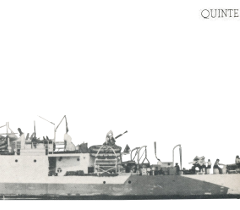
|
|
Copyright © 2011, 2014 Anne Gafiuk, all rights reserved, Website by KroTek Electronics |
|

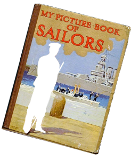 I still have the book. I wouldn't part with it for $1,000,000!" George expounds and laughs again. "I had no other reason that I can think of - when my mother, dad, sister and I went to the West Coast and we went to Victoria when I was thirteen or fourteen. You can't really even see the ocean there, though."
I still have the book. I wouldn't part with it for $1,000,000!" George expounds and laughs again. "I had no other reason that I can think of - when my mother, dad, sister and I went to the West Coast and we went to Victoria when I was thirteen or fourteen. You can't really even see the ocean there, though."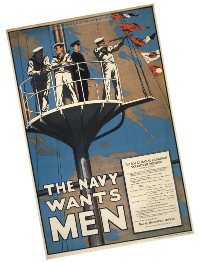 I told him, 'I want to join the Fleet Air Arm' and was told that Canada did not have one. He told me that we just had a Navy. So I said, 'Well, fine, then I will just join the Navy.' He told me to go home and get dried behind my ears! I'll never forget that!" George remembers being very angry at the man's attitude. He took the application and told him he would be back. When school was out the following year in June, George had his application filled out. "With my mother and sister on vacation out to the coast, my father and I were at home. I talked him into signing my application because I was underage. And he did. It might have been a patriotic thing as my father was British and in the First World War."
I told him, 'I want to join the Fleet Air Arm' and was told that Canada did not have one. He told me that we just had a Navy. So I said, 'Well, fine, then I will just join the Navy.' He told me to go home and get dried behind my ears! I'll never forget that!" George remembers being very angry at the man's attitude. He took the application and told him he would be back. When school was out the following year in June, George had his application filled out. "With my mother and sister on vacation out to the coast, my father and I were at home. I talked him into signing my application because I was underage. And he did. It might have been a patriotic thing as my father was British and in the First World War."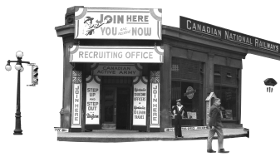 about three weeks. They told me when to report. On that particular train from Lethbridge to Calgary there were fifty to sixty kids that had signed up. We stayed in Calgary overnight then took the train through the mountains, picking kids up all along the way; some even were on the train from Winnipeg and Medicine Hat! Then we took a boat from Vancouver to Esquimalt on a Sunday morning and that is the first time I saw the ocean since that holiday with my family! They herded us into these transport trucks out to the Naval Barracks and we had breakfast." Sunday breakfast was a highlight for the young men: bacon and stewed tomatoes, toast and coffee, nicknamed Red Leaded Bacon. Monday to Friday: porridge. The other meals fruit and vegetables were included. "Some people complained, but I didn't mind the food."
about three weeks. They told me when to report. On that particular train from Lethbridge to Calgary there were fifty to sixty kids that had signed up. We stayed in Calgary overnight then took the train through the mountains, picking kids up all along the way; some even were on the train from Winnipeg and Medicine Hat! Then we took a boat from Vancouver to Esquimalt on a Sunday morning and that is the first time I saw the ocean since that holiday with my family! They herded us into these transport trucks out to the Naval Barracks and we had breakfast." Sunday breakfast was a highlight for the young men: bacon and stewed tomatoes, toast and coffee, nicknamed Red Leaded Bacon. Monday to Friday: porridge. The other meals fruit and vegetables were included. "Some people complained, but I didn't mind the food."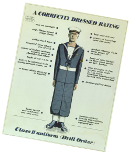 Then you had your silk that went around your neck. You had to fold it and iron it flat and that went around your neck. It was joined behind your neck. You got a lanyard and of course: two hats and a hat box. The white hats are the summer hats for summer dress. The dark ones are for winter. There was a superstition: you do not put your Navy hat upside down and put it on the bed; definitely not on the bed!" George stresses. "We also got a little ditty bag, like a very small suitcase....oh, you had a lot of clothes and there was an allowance of $0.15 per day to replace anything, like socks," he adds.
Then you had your silk that went around your neck. You had to fold it and iron it flat and that went around your neck. It was joined behind your neck. You got a lanyard and of course: two hats and a hat box. The white hats are the summer hats for summer dress. The dark ones are for winter. There was a superstition: you do not put your Navy hat upside down and put it on the bed; definitely not on the bed!" George stresses. "We also got a little ditty bag, like a very small suitcase....oh, you had a lot of clothes and there was an allowance of $0.15 per day to replace anything, like socks," he adds.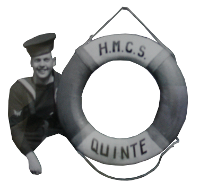 Returning to his training days, George describes the four watches: Red, Green, Blue and White. "If you were off Wednesday afternoon, it would put you off on the weekend, but if it was the other way around, you would only get one day off on the weekend to go to town." With only $15.00 a month being under 18 years of age, and $10.00 of it saved by the Navy for the young sailor, George only had $5.00 a month to spend. When George turned 18, he received his back pay and earned $37.50, sending a portion home to his mother, spending the rest. "It worked out well. We only got out of barracks once or twice a week, depending upon which watch we were on. I don't think I had more money than others. When I went to town, I could afford something to eat. There was a dairy in Victoria called the Model Dairy. A milkshake was 10 cents. I'd go. I never learned to drink to excess. When you were a boy," he asserts, "you never went into a pub!"
Returning to his training days, George describes the four watches: Red, Green, Blue and White. "If you were off Wednesday afternoon, it would put you off on the weekend, but if it was the other way around, you would only get one day off on the weekend to go to town." With only $15.00 a month being under 18 years of age, and $10.00 of it saved by the Navy for the young sailor, George only had $5.00 a month to spend. When George turned 18, he received his back pay and earned $37.50, sending a portion home to his mother, spending the rest. "It worked out well. We only got out of barracks once or twice a week, depending upon which watch we were on. I don't think I had more money than others. When I went to town, I could afford something to eat. There was a dairy in Victoria called the Model Dairy. A milkshake was 10 cents. I'd go. I never learned to drink to excess. When you were a boy," he asserts, "you never went into a pub!"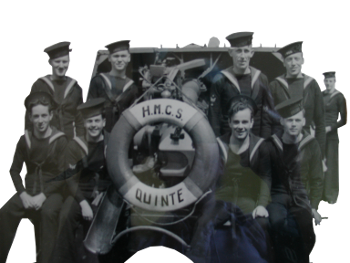 once again remin iscing about his early years. "You chang ed ham mocks every two weeks, I be lieve. You took your clews off - the ropes that hold it up --- and you had to take them off and put them on your other hammock. Anyway, you would wash that hammock, scrub it, and clean it. I used to do that for the guys and I would charge them $2.00!"
once again remin iscing about his early years. "You chang ed ham mocks every two weeks, I be lieve. You took your clews off - the ropes that hold it up --- and you had to take them off and put them on your other hammock. Anyway, you would wash that hammock, scrub it, and clean it. I used to do that for the guys and I would charge them $2.00!"